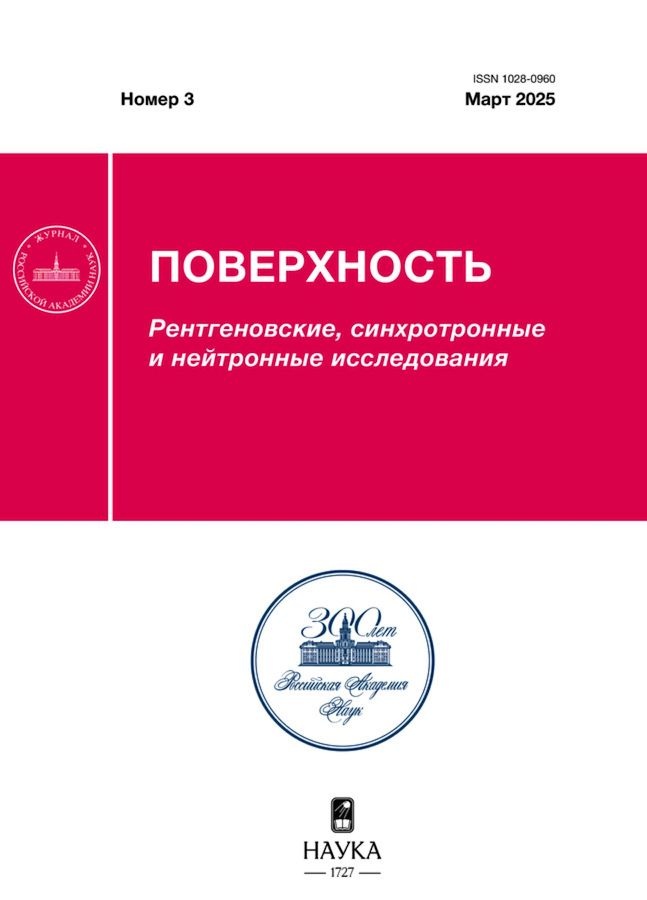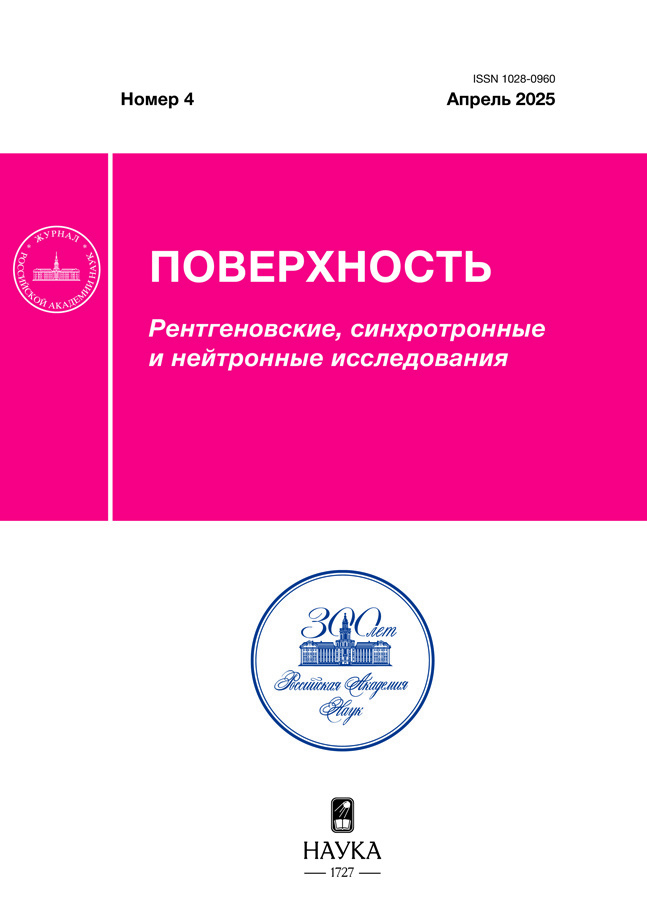Исследование пленок SiO2, полученных методом PECVD и легированных ионами Zn
- Авторы: Привезенцев В.В.1, Фирсов А.А.1, Куликаускас В.С.2, Затекин В.В.2, Кириленко Е.П.3, Горячев А.В.3
-
Учреждения:
- Национальный исследовательский центр “Курчатовский институт”–НИИ системных исследований
- Московский государственный университет им. М.В. Ломоносова, НИИЯФ им. Д.В. Скобельцына
- Институт нанотехнологий микроэлектроники РАН
- Выпуск: № 4 (2025)
- Страницы: 70-74
- Раздел: Статьи
- URL: https://ter-arkhiv.ru/1028-0960/article/view/689195
- DOI: https://doi.org/10.31857/S1028096025040106
- EDN: https://elibrary.ru/FCFSZP
- ID: 689195
Цитировать
Полный текст
Аннотация
Представлены результаты исследования пленок оксида кремния, полученных методом PECVD на Si-подложках. Их имплантировали ионами 64Zn+ с энергией 50 кэВ (доза 7 × 1016 cм–2), а затем отжигали в атмосфере кислорода при повышенных температурах. Обнаружено, что после имплантации в пленке SiO2 цинк распределен по нормальному закону с максимумом около 40 нм. После имплантации цинк находится в пленке оксида кремния как в металлической фазе (ближе к поверхности пленки), так и в окисленном состоянии (в глубине пленки). После отжигов до 800°С профиль цинка смещается вглубь пленки, в этом случае цинк находится в пленке только в окисленном состоянии. При высоких температурах (более 800°С) профиль цинка смещается к поверхности пленки.
Ключевые слова
Полный текст
Об авторах
В. В. Привезенцев
Национальный исследовательский центр “Курчатовский институт”–НИИ системных исследований
Автор, ответственный за переписку.
Email: v.privezentsev@mail.ru
Россия, Moсква
А. А. Фирсов
Национальный исследовательский центр “Курчатовский институт”–НИИ системных исследований
Email: v.privezentsev@mail.ru
Россия, Moсква
В. С. Куликаускас
Московский государственный университет им. М.В. Ломоносова, НИИЯФ им. Д.В. Скобельцына
Email: v.privezentsev@mail.ru
Россия, Moсква
В. В. Затекин
Московский государственный университет им. М.В. Ломоносова, НИИЯФ им. Д.В. Скобельцына
Email: v.privezentsev@mail.ru
Россия, Moсква
Е. П. Кириленко
Институт нанотехнологий микроэлектроники РАН
Email: v.privezentsev@mail.ru
Россия, Москва
А. В. Горячев
Институт нанотехнологий микроэлектроники РАН
Email: v.privezentsev@mail.ru
Россия, Москва
Список литературы
- Старостин В.В. Материалы и методы нанотехнологий. М.: БИНОМ, 2015. 434 с.
- Litton С.W., Collins T.C., Reynolds D.S. Zinc Oxide Material for Electronic and Optoelectronic Device Application. Chichester: Wiley, 2011.
- Neshataeva E., Kümmell T., Bacher G., Ebbers A. // Appl. Phys. Lett. 2009. V. 94. P. 091115. https://doi.org/10.1063/1.3093675
- Chu S., Olmedo M., Yang Zh. et al. // Appl. Phys. Lett. 2008. V. 93. P. 181106. https://doi.org/10.1063/1.3012579
- Smestad G.P., Gratzel M. // J. Chem. Educ. 1998. V. 75. P. 752. https: j.chem.wisc.edu.
- Li C., Yang Y., Sun X.W., Lei W., Zhang X.B., Wang B.P., Wang J.X., Tay B.K., Ye J.D., Lo G.Q., Kwong D.L. // Nanotechnology. 2007. V. 18. P. 135604. https://doi.org/10.1088/0957-4484/18/13/135604
- Mehonic A., Shluger A.L., Gao D., Valov I., Miranda E., Ielmini D., Bricalli A., Ambrosi E., Li C., Yang J.J., Xia Q., Kenyon A.J. // Adv. Mater. 2018. V. 30. 43. P. 1801187. https://doi.org/10.1002/adma.201801187
- Sirelkhatim A., Mahmud S., Seeni A., Kaus N.H.M., Ann L.C., ohd Bakhori S.K., Hasan H., Mohamad D. // Nano-Micro Lett. 2015. V. 7. P. 219. https://doi.org/10.1007/s40820-015-0040-x
- Inbasekaran S., Senthil R., Ramamurthy G., Sastry T.P. // Intern. J. Innov. Res. Sci. Eng. Technol. 2014. V. 3. P. 8601. www.ijirset.com.
- Straumal B.B., Mazilkin A.A., Protasova S.G., Myatiev A.A., Straumal P.B., Schütz G., van Aken P.A., Goering E., Baretzky B. // Phys. Rev. B. 2009. V. 79. P. 205206. https://doi.org/10.1103/PhysRevB.79.205206
- Ilyas N., Li C., Wang J., Jiang X., Fu H., Liu F., Gu D., Jiang Y., Li W. // J. Phys. Chem. Lett. 2022. V. 13 (3). P. 884. https://doi.org/10.1021/acs.jpclett.1c03912
- Qin F., Zhang Y., Guo Z. et al. // Mater. Adv. 2024. V. 5. P. 4209. https://doi.org/10.1039/d3ma01142
- Okulich E.V., Okulich V.I., Tetelbaum D.I., Mikhaylov A.N. // Mater. Lett. 2022. V. 310. P. 131494. https://doi.org/10.1016/j.matlet.2021.131494
- Mehonic A., Gerard T., Kenyon A.J. // Appl. Phys. Lett. 2017. V. 111. P. 233502. https://doi.org/10.1063/1.5009069
- Chang K.C., Tsai T.M., Chang T.C., Wu H.H., Chen J.H., Syu Y.E., Chang G.W., Chu T.J., Liu G.R., Su Y.T., Chen M.C., Pan J.H., Chen J.Y., Tung C.W., Huang H.C., Tai Y.H., Gan D.S., Sze S.M. // IEEE Eelecron. Dev. Lett. 2013. V. 34 (9). P. 399. https://doi.org/10.1109/LED.2013.2241725
- Privezentsev V.V., Kulikauskas V.S., Zatekin V.V., Kiselev D.A., Voronova M.I. // J. Surf. Invest.: X-ray, Synchrotron Neutron Tech. 2022. V. 16 (3). P. 402. https://doi.org/ 10.1134/S1027451022030314
- Hofmann S. Auger- and X-Ray Photoelectron Spectroscopy in Material Science. Berlin Heidelberg: Springer–Verlag, 2013.
- Анализ поверхности методами оже- и рентгеновской фотоэлектронной спектроскопии / Ред. Бриггс Д., Сих М.П. М.: Мир, 1987. 600 с.
- Монахова Ю.Б., Муштакова С.П. // Журнал аналитической химии. 2012. Т. 67. Вып. 12. С. 1044.
- SIMNRA code. https://mam.home.ipp.mpg.de/
- Ziegler J.F., Biersack J.P. SRIM 2013 (http://www.srim.org).
Дополнительные файлы
















